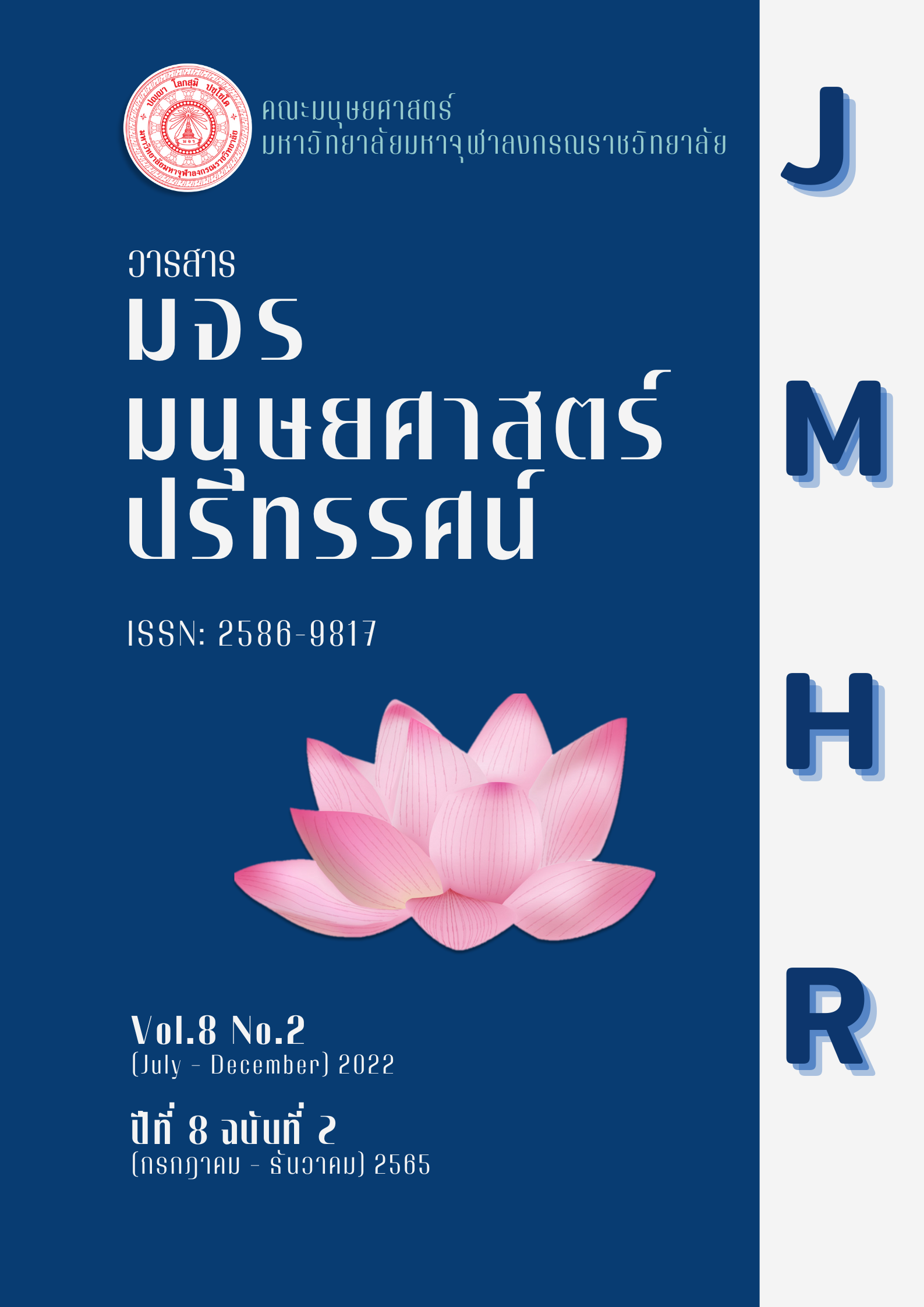การรับรู้ข้อมูลด้านหลักสูตรของนิสิตหลักสูตรศิลปศาสตรบัณฑิต สาขาวิชาภาษาญี่ปุ่น คณะศิลปศาสตร์ มหาวิทยาลัยพะเยา
คำสำคัญ:
การรับรู้, หลักสูตร, การประชาสัมพันธ์, ศิลปศาสตรบัณฑิต, มหาวิทยาลัยพะเยาบทคัดย่อ
การศึกษาครั้งนี้มีวัตถุประสงค์ เพื่อศึกษาการรับรู้ข้อมูลหลักสูตรและช่องทางการประชาสัมพันธ์ด้านหลักสูตรของนิสิตหลักสูตรศิลปศาสตรบัณฑิต สาขาวิชาภาษาญี่ปุ่น คณะศิลปศาสตร์ มหาวิทยาลัยพะเยา เป็นการวิจัยแบบผสมผสาน (mixed-method) ซึ่งมีกลุ่มตัวอย่างเป็นนิสิตสาขาวิชาภาษาญี่ปุ่น ชั้นปีที่ 1 ปีการศึกษา 2564 จำนวน 30 คน กลุ่มตัวอย่างสำหรับการสัมภาษณ์ 5 คน ได้มาโดยการเลือกแบบเจาะจง เครื่องมือที่ใช้ในการวิจัย ได้แก่ แบบสอบถาม สถิติที่ใช้ในการวิเคราะห์ข้อมูล ได้แก่ ความถี่ ร้อยละ ค่าเฉลี่ย และค่าเบี่ยงเบนมาตรฐาน ผลการศึกษา พบว่า ภาพรวมของการรับรู้การประชาสัมพันธ์หลักสูตรคณะศิลปศาสตร์ของนิสิตสาขาวิชาภาษาญี่ปุ่น อยู่ในระดับมาก (Mean = 3.80) โดยช่องทางการประชาสัมพันธ์ที่มีผลต่อการรับรู้ข้อมูลของนิสิตสาขาวิชาภาษาญี่ปุ่นมากที่สุดคือ Facebook ประชาสัมพันธ์ของคณะฯและส่วนงาน (Mean = 4.07) รองลงมาได้แก่ ครูแนะแนว (Mean = 3.93) และช่องทางการประชาสัมพันธ์ที่มีผลต่อการรับรู้ข้อมูลของนิสิตสาขาวิชาภาษาญี่ปุ่นน้อยที่สุด คือ ผู้ปกครอง (Mean = 2.43 ) สำหรับช่องทางโซเชียลมีเดียที่มีผลต่อการรับรู้ข้อมูลข่าวสารของนิสิต พบว่า Facebook เป็นช่องทางโซเชียลมีเดีย ที่มีผลต่อการรับรู้ข้อมูลข่าวสารของนิสิตมากที่สุดคิดเป็นร้อยละ 80 รองลงมาได้แก่ Twitter คิดเป็นร้อยละ 13.34 นอกจากนี้ผลการสัมภาษณ์ยังระบุว่านิสิตรับรู้ข้อมูลหลักสูตรผ่านครูแนะแนวและ Facebook ประชาสัมพันธ์ของคณะและส่วนงานเป็นหลัก
เอกสารอ้างอิง
ทัศนีย์ หมอสอน. (2559). การรับรู้ข้อมูลของนักเรียนจากสื่อประชาสัมพันธ์หลักสูตรการจัดการสารสนเทศ คณะ มนุษยศาสตร์และสังคมศาสตร์ มหาวิทยาลัยราชภัฏนครศรีธรรมราช. วารสารนาคบุตรปริทัศน์, 8(2), 70-74.
นลินี พานสายตา. (2555). การรับรู้ภาพลักษณ์ คุณภาพบัณฑิต หลักสูตรและการเรียนการสอนของนักศึกษาทีมีต่อสถาบันอุดมศึกษาภาครัฐ (วิทยานิพนธ์ปริญญาวิทยาศาสตรมหาบัณฑิต). สถาบันบัณฑิตพัฒนบริหารศาสตร์ : กรุงเทพฯ.
นงเยาว์ ขัติวงษ์. (2562). การศึกษาช่องทางการรับรู้สื่อประชาสัมพันธ์ที่ส่งผลต่อการศึกษาต่อในระดับปริญญาตรีของนักศึกษามหาวิทยาลัยเทคโนโลยีราชมงคลธัญบุรี (รายงานผลการวิจัย). มหาวิทยาลัยเทคโนโลยีราชมงคลธัญบุรี : ปทุมธานี.
ปริยา รินรัตนากร. (2562). การรับรู้เกี่ยวกับหลักสูตรและแนวโน้มการศึกษาต่อในหลักสูตรนิเทศศาสตร์ในยุคการสื่อสารผ่านสื่อสังคมออนไลน์. วารสารบัณฑิตศึกษาปริทรรศน์, 15(1), 143-157.
พิมลวรรณ มหาชัย. (2557). พัฒนาการของการประชาสัมพันธ์สำหรับภาคการศึกษา กรณีศึกษาวิทยาลัยนวัตกรรม มหาวิทยาลัยธรรมศาสตร์. กรุงเทพฯ: มหาวิทยาลัยธรรมศาสตร์.
บริษัทมาร์เก็ตเธียร์จำกัด. (2564). โซเชียลมีเดียยอดนิยมในไทยมีจำนวนผู้ใช้โซเชียลมีเดียในไทยเท่าไรกัน?. สืบค้นเมื่อ 3 ธันวาคม 2565, จาก https://marketeeronline.co/archives/208649
รุ่งนภา พิตรปรีชา. (2560). พลังแห่งการประชาสัมพันธ์. นนทบุรี: บริษัท 21 เซ็นจูรี่ จำกัด.
วิชัย วงศ์ใหญ่. (2532). การพัฒนาหลักสูตรแบบครบวงร. กรุงเทพมหานคร : โรงพิมพ์จุฬาลงกรณ์มหาวิทยาลัย.
สุรพงษ์ โสธนะเสถียร. (2556). ทฤษฎีการสื่อสาร. กรุงเทพฯ: สำนักพิมพ์ระเบียงทอง.
สำนักงานสถิติแห่งชาติ. (2565). สรุปผลที่สำคัญสำรวจการมีการใช้เทคโนโลยีสารสนเทศและการสื่อสารในครัวเรือน พ.ศ.2563. สืบค้นเมื่อ 3 ธันวาคม 2565, จาก https://www.nso.go.th/sites/2014/DocLib13/ด้านICT/ เทคโนโลยีในครัวเรือน/2563/Pocketbook63.pdf
สำนักงานสภาพัฒนาการเศรษฐกิจและสังคมแห่งชาติ. (2564). ร่างแผนพัฒนาเศรษฐกิจและสังคมแห่งชาติ ฉบับที่13 พ.ศ. 2566-2570. สืบค้นเมื่อ 3 ธันวาคม 2565, จาก https://www.nesdc.go.th/download/Plan13/Doc/Plan13_DraftFinal.pdf
อรุณรัตน์ ชินวรณ์. (2553). สื่อประชาสัมพันธ์. กรุงเทพฯ: สำนักพิมพ์แห่งจุฬาลงกรณ์มหาวิทยาลัย.
อุษณีย์ พรมเดื่อ และมาลี กาบมาลา. (2562). การศึกษาความต้องการสารสนเทศที่มีผลต่อการตัดสินศึกษาต่อหลักสูตรระดับปริญญาตรี มหาวิทยาลัยราชภัฏชัยภูมิ. วารสารบัณฑิตศึกษา, 16(72), 176-182.

ดาวน์โหลด
เผยแพร่แล้ว
รูปแบบการอ้างอิง
ฉบับ
ประเภทบทความ
หมวดหมู่
สัญญาอนุญาต
ลิขสิทธิ์ (c) 2022 วารสาร มจร มนุษยศาสตร์ปริทรรศน์

อนุญาตภายใต้เงื่อนไข Creative Commons Attribution-NonCommercial-NoDerivatives 4.0 International License.





